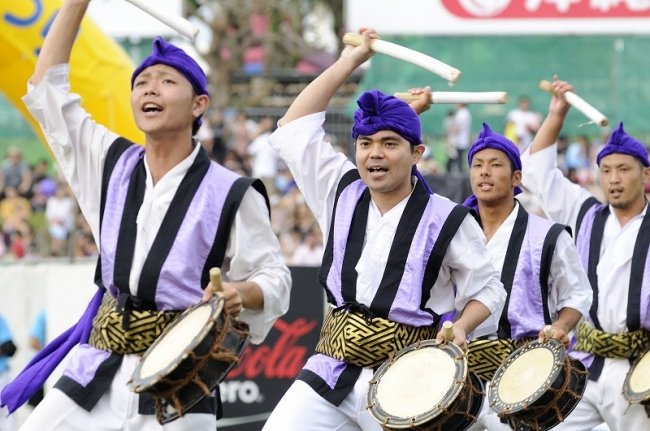Once limited to the Festival of the Dead within villages, by villagers, and in a religious context, in postwar Okinawa Eisa has been transformed to an all year festival entertainment performed everywhere and without any religious context. In short: Today’s Eisa is a modern reinvention.
Originally, sad songs called “Chunjun-nagari” were the only songs performed during Eisa, and “it was really preachy and exceedingly uninteresting, just quietly chanting Nenbutsu [Pure Land Buddhism] prayers. Then, around 1946 or 47, I was taught a new, fast-moving Eisa dance from the neighboring village. I was 16 or 17 years old. … With the new Eisa dance, the aspect of ancestral memorial service disappeared, and it has become Eisa dance as an entertainment.” (story told by 81-year-old person from Yamada, Nago City)
Nowadays, Eisa has come to refer to “Taiko Eisa” in which men and women dance incessantly in flashy costumes and to the rhythm of taiko drums and one-sided hand drums (pāranku). It is also this style of Eisa that is performed both in central Japan and abroad. And it was the “1st All Island Eisa Competition” held in Koza City in 1956 that created the opportunity for Taiko Eisa to dominate the whole of Okinawa. Since this competition was held, the Young Men’s Associations of all villages in Okinawa have been developed through repeated reforms to compete with the districts. Unlike central Japan, Okinawan young men’s associations have been organized and active in each village. Therefore, this form of village rivalry has become a major factor in concentrating the energy of young people. The winning group was picked up by the media and became famous, and there was a flood of requests for instruction from all over the prefecture, which triggered the spread of Taiko Eisa in the central Okinawa region as a standard dance throughout the prefecture.
In addition, as a response to disorder and violence at night brought about by the occupying armed forces, vigilant organizations were spontaneously formed in the settlements, which marked a new rise of the young men’s associations in many postwar settlements, who were the main renewers of Eisa. At the same time, Eisa was also an entertainment venue for kata of karate put on display as an entertainment, where bets and gambling called Chankurū were held as well.
SOURCE: Itani Yasuhiko: Social education as an Okinawan custom seen in the “penalty tag” system of the Customary Laws of Southern Island Villages (Nantō Mura Neihō). Dissertation submitted in partial fulfillment of the requirements for the degree of Doctor in Education. Waseda University Number: New 7911. Waseda University 2018.
© 2022, Andreas Quast. All rights reserved.

